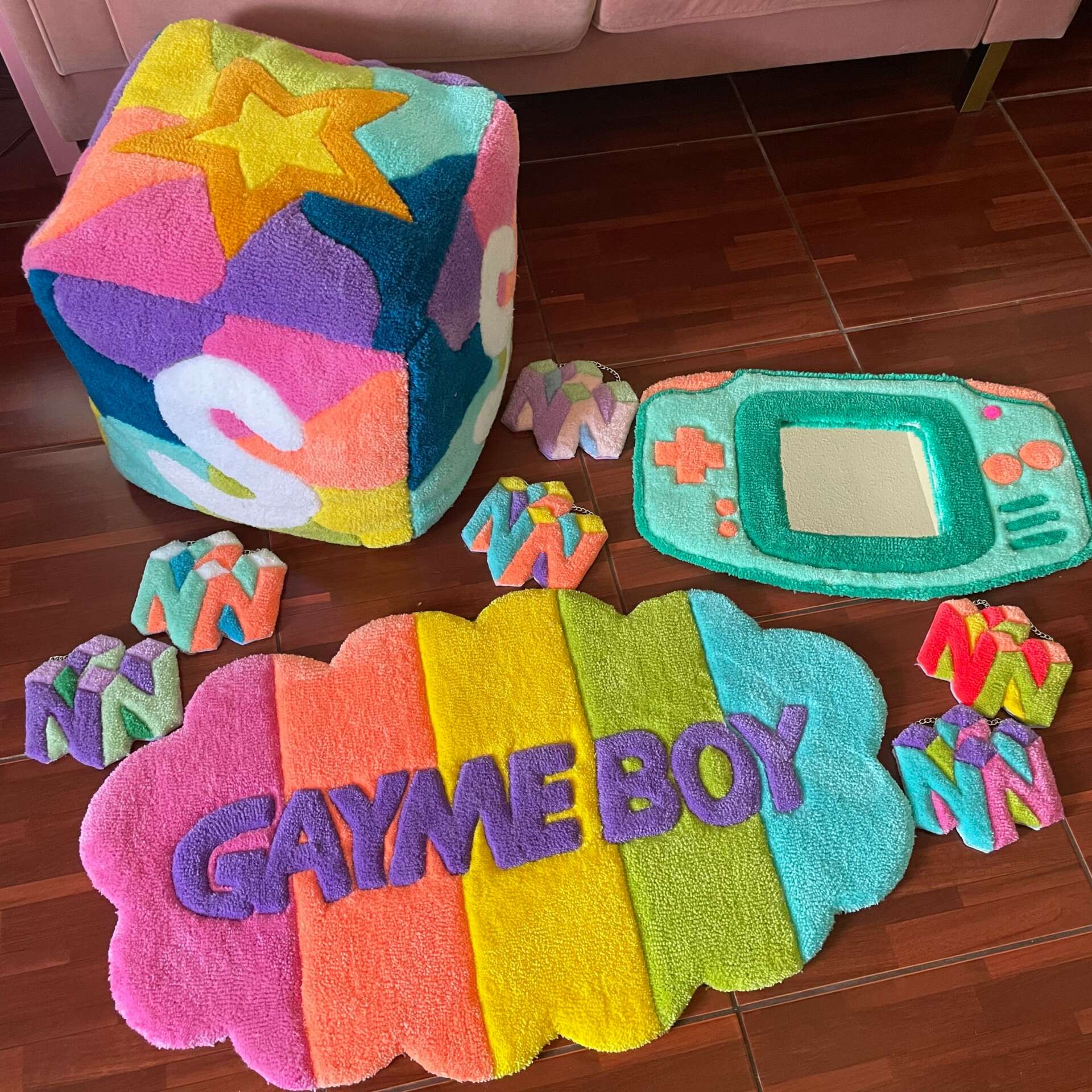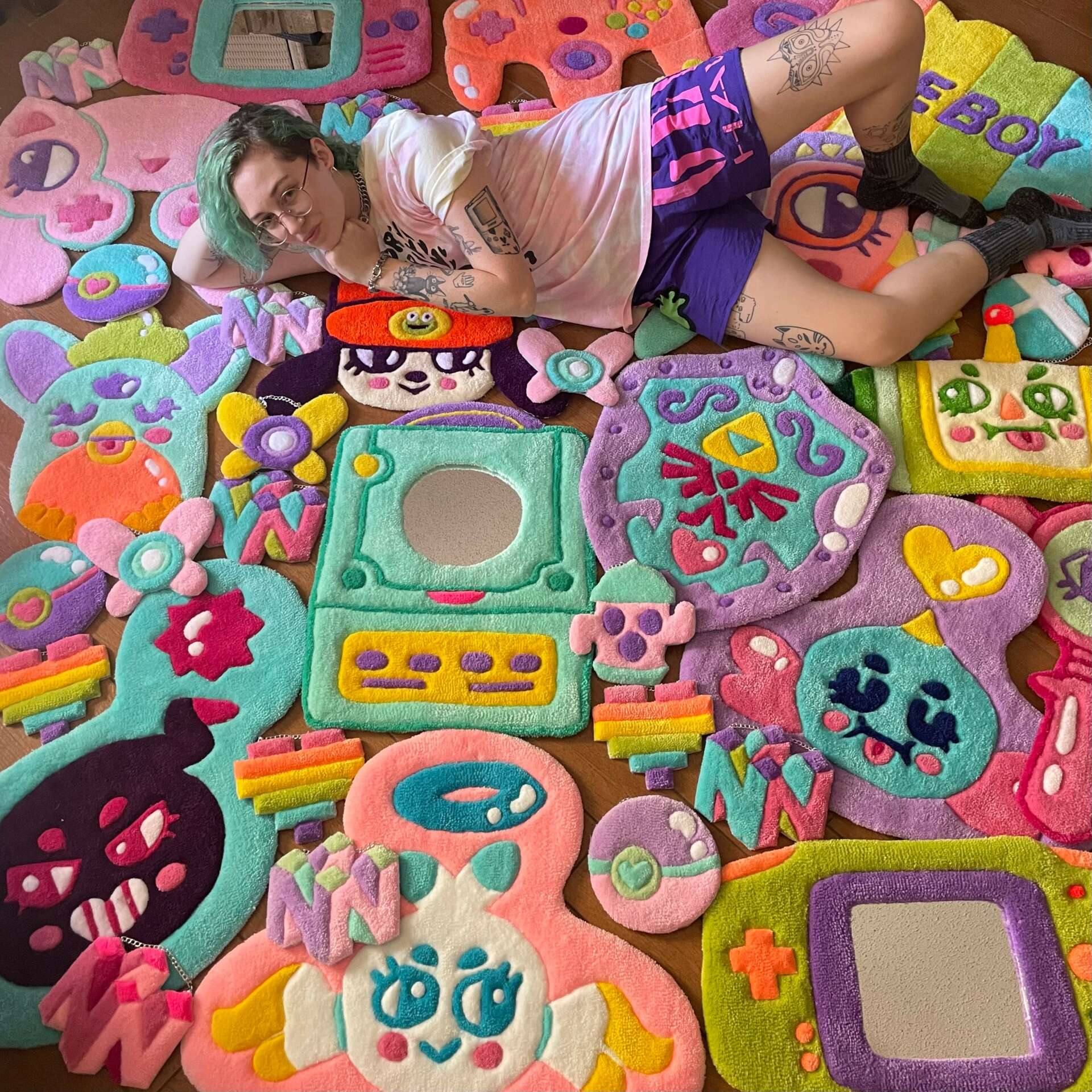Alright – so today we’ve got the honor of introducing you to Ollie Crain. We think you’ll enjoy our conversation, we’ve shared it below.
Ollie, appreciate you joining us today. How did you learn to do what you do? Knowing what you know now, what could you have done to speed up your learning process? What skills do you think were most essential? What obstacles stood in the way of learning more?
I learned to tuft rugs mainly from watching YouTube tutorials. I’m a firm believer in teaching yourself if you really want to do something since there is so much information online. However, I completely understand that this can be overwhelming at times. Fortunately, there weren’t too many sources of information about tufting when I first started, so I was able to focus on just a few sources and experiment until things felt right for me. I’m not sure if I would change anything about the way I learned this craft. I don’t feel like I could have learned it more quickly if I had an in person teacher necessarily, and most of what I’ve learned has been through trial and error combined with just doing it as much as possible. I prefer learning things at my own pace, so teaching myself and doing my own research helped me stay focused. I only started a couple years ago, so I’m still very much learning all the time though, and I would say the biggest hurdles have been around learning how to run a small business.
I do think that it helped that I have been a jack-of-all-trades (master of none!) crafter for many many years. I have an entire dresser full of craft supplies that I’ve amassed from getting into this and that, so picking up a crafting skill and learning it was nothing new. However, sticking with it is something completely new to me! I knew right away that I was hooked, but I was really nervous about investing more money into my set up initially since I have a habit of getting bored with a craft and moving on to my next temporary obsession. Thankfully, rug making has continued to hold my attention, and the thought of seeing the progress in my work many years from now keeps me excited to hone my skills.
The biggest obstacle I’ve come across was midway in my learning process. As I mentioned, when I first started learning how to make rugs, I didn’t have many sources of information. This was good for my focus, but Not So Good when I later came across a specific issue that wasn’t addressed in these sources. Additionally, most of the content I was consuming was geared towards beginners and getting set up. So once I had those skills down, I started coming across problems that weren’t talked about in any of the stuff I was reading and watching. This is why I started making my own tutorial content – I had a feeling I wasn’t the only person having these issues, and I wanted people that were further along in their rug making journey to have more resources to troubleshoot and build on their skills. And by sharing the knowledge I had with others, I met other rug makers and got involved in a whole community of people that all seemed to be figuring the craft out together.


Awesome – so before we get into the rest of our questions, can you briefly introduce yourself to our readers.
I’m Ollie (they/them), and I’m a queer fiber artist and rug maker residing in Austin, Texas. I tried out punch needle rug making in the fall of 2020, bought my first tufting machine a month or so later, and I haven’t stopped making rugs since. I became aware of the craft when my best friend showed me a YouTube video of a person making a punch needle rug. Shortly after, I experienced a really difficult loss, and I needed something to keep my brain and hands busy while I grieved. By early 2021, I was toying with the idea of selling my rugs, and I was lucky enough to have a tufting video that I made go viral. From there, I continued to make rugs, along with content about the rug making process, to build the community that I have today. I create bright, soft, handmade wall hangings by using rug making techniques and designs inspired by my childhood. While rug making has certainly taken off in the last couple years, I feel I stand out by making my own transformative fanart, often times centered around retro video games. I also utilize a sculpting technique to give my pieces extra definition and texture – this art is meant to be touched! I no longer take commission work regularly, and I feel so thankful that the demand for my work rarely leaves more than a few pieces in stock outside of my shop updates. I’ve been creating rugs, stickers, shirts, and content full time since July of 2021.
For those interested in learning the craft of rug making for themselves, I provide tutorials and one on one coaching through my Patreon.



We often hear about learning lessons – but just as important is unlearning lessons. Have you ever had to unlearn a lesson?
In high school, my art teacher was very fine art focused. I think this was pretty typical for art teachers back then. Anime and older children’s cartoons were becoming more prevalent, and my teacher seemed to be frustrated that I wanted to focus on more low brow styles. She discouraged me from drawing anime and cartoon characters, and instead had me focus on technical drawing and expressionist painting. I remember her trying so hard to get me into watercolor painting, her area of expertise. This was my nightmare; I feel best in mediums that I can carefully control. While I do understand that she wanted me to learn the technical aspects of drawing and painting before I curated a style and began experimenting with my own ‘cartoons,’ I wish she would have given me the space to do both! Ultimately, the lesson I learned was that I either needed to go into graphic design, trick my brain into studying fine art, or give up on my silly little art career dreams. For a while, I kept making art, but I always heard those voices telling me I wasn’t making ‘real’ art. So I worked on crafts instead, but then I heard voices telling me that crafts couldn’t be ‘real’ art either. It took a lot of staring at other people’s art that I respected on tumblr, and seeing them get hired to make the cartoons and comics that I loved, to finally realize there could be a place for me too. I just had to keep on making shit and find my people. And over a decade after dropping out of my Art Education major, I finally figured out the shit I want to make and found the people I want to make it for.



How did you build your audience on social media?
I’ve been very interested in the social dynamics of the internet for a long time. Over the years, I noticed that I was most drawn to more authentic internet personalities, and I knew if I ever had a public presence online, that this is where I would want to be. However, I’m also aware that nothing is truly authentic on the internet, as your decision to post negates that authenticity a bit, so it’s a balancing act. When I really started building a following, I think it was because I was being as authentic as I could be while also posting A LOT. I paid attention to how other successful rug making accounts functioned, and I noticed that people enjoyed process videos. Then I studied those process videos, I thought about how I could make my own, and I started documenting my process and sharing it with others. I posted every day, I planned my content, and I consumed a lot of content to get ideas and figure out what worked for others. When you’re first building your social media presence, be prepared to be chronically online. Social media is a whole other set of skills, but just like anything else, you can learn how to do it with practice. I have a love/hate relationship with social media. I love that it gives me the ability to market my work and continue to do what I love, but it takes a serious toll on my mental health. Make sure to set boundaries with yourself and others while you build your following. It’s really common for people to think that since you exist on the internet, you are inviting any and all criticism, your work is okay to steal, and you’re not a real person with real feelings. Challenge that! Remember to take breaks from it, especially if it’s causing you anxiety to keep up with posting. And keep in mind that while it’s nice to be authentic, your social media presence is curated marketing, and it doesn’t have to be any more than that if you don’t want it to be.
Contact Info:
- Website: www.chronicthehedgehogrugs.com
- Instagram: chronic_the_hedgeh0g
- Other: Patreon: www.patreon.com/chronicthehedgehog


